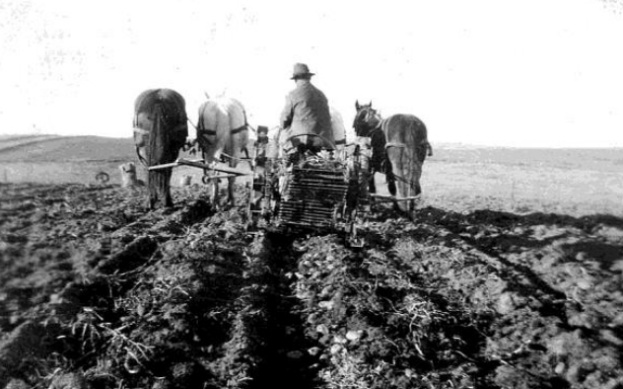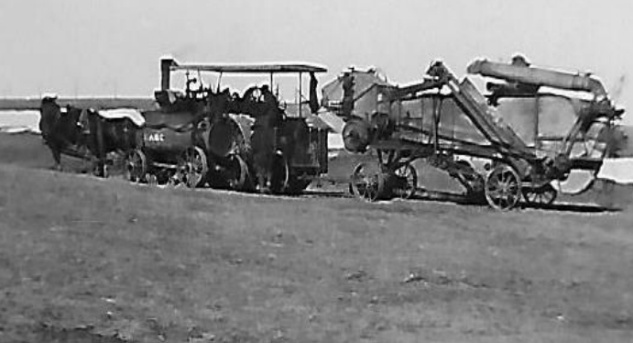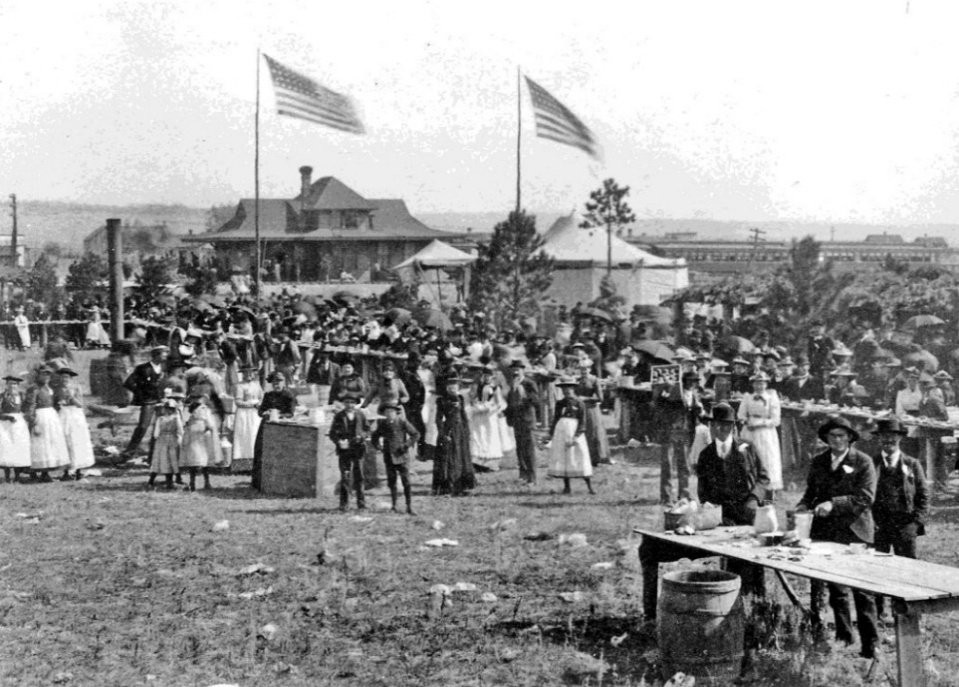Dryland Farming on the Palmer Divide


Simply put, dryland farming is when you rely on Mother Nature to provide the water for your crops. Conversely, irrigation is the practice of applying additional water (beyond what is available from rain) to the soil in order to enable or enhance plant growth and yield. Irrigation was not prevalent in the mid 1800’s and certainly not on The Divide when it was first settled in the 1860’s. On The Divide, dryland farming prevailed.
Dryland farming is agriculture without irrigation and works well in areas where the wet seasons are usually the winter or early spring. These areas receive about 15” precipitation annually, most commonly in the form of snow. Moisture from the snow is stored in the soil and the crops use that moisture to germinate and grow. Good soil combined with plentiful snowfall produces good crops. The Divide was well-suited to this form of farming.
Imagine being a pioneer leaving the rich, dark soil of the Midwestern farm belt and heading west. As you start to cross the Great Plains, you are gaining altitude and it’s getting drier. You can see why this was called the Great American Desert. But you keep going and you start to enter a ponderosa pine forest with lush meadows and then mesa table-land with high native grasses and numerous ground waters. THIS IS IT! This is where you will settle. It becomes known as The Divide with headwaters to numerous creeks—Kiowa, Bijou, East Cherry, West Cherry, Antelope, Jackson, Pine, Black Squirrel. Some flow north to the Platte River; some south to the Arkansas River. The soil is rich sandy and clay loam; the bottom lands are rich black loam. There is no alkali or adobe.
First you plant crops for your own sustenance—wheat, barley, rye, and garden crops like turnips, potatoes, lettuce, carrots, peas, and beans. You grind the grains in your own mill into flour. You bale native grasses to feed your livestock along with wheat and alfalfa. You milk your cows and churn butter and make cheese with milk and cream. You sell what you don’t need and hopefully have enough to get you through the winter. As time goes on, you learn the ways of the land—it is high altitude (7,800 ft. above sea level at its highest) with a short growing season (the time between frosts was only around three months). Corn doesn’t have time to mature although you might get a few ears from your garden as a treat. Fruit trees don’t do well. Long oats are a good crop. Potatoes do great and become a cash crop (one that you can sell over and above what you use for yourself). Winters are harsh and long, and it is still very much a frontier. But you are hooked by its spirit and you will stay. You have become a dryland farmer–much different from the Midwest from where you had come.

More settlers came and communities began to appear on The Divide—Spring Valley, Gwillimville, Table Rock—to serve as hubs for commerce. Here is where the farmers would bring their excess crops, butter, and cheeses to sell or to transport to the bigger towns just developing along the railroad lines (Monument, Greenland, Eastonville). Mr. A. A. Hayes of The Boston Advertiser visited Gwillimville in 1879, and wrote “Although we were 8,000 feet above the sea, and no stream is found here, there was not the slightest need of irrigation. . . grass from five to six feet high, and fields of oats nearly over my head, and Colorado grain, when it does grow, will ‘beat the world,’ as my cicerone (tour guide) very correctly remarked. Then came millet, wild barley, timothy (a perennial short grass) and alfalfa, or Chilian Clover; then beets, turnips and peas in splendid condition, and potatoes of different varieties, running up to twenty-seven in marketable condition, to the vine.” Cheese from the area won many blue ribbons—Black Canyon from Spring Valley, Blue Hill from Eastonville, Black Diamond from Gwillimville/ Monument– attributed to the high quality of the grasses, pure water, and low temperatures which enabled the cows to produce rich cream and milk.

In 1887, the Agricultural College of Colorado (now Colorado State University) partnered with local farmers and created the Divide Experiment Station on a forty-acre piece of land near Table Rock. In 1888 high destructive winds; hail and excessive rain all occurred through mid-summer. In contrast, August had no moisture at all and a drought continued until fall. 1893 only had 9.87 inches of precipitation. Then 1894 was back to normal. The Divide was a challenge for dryland farming due to the altitude and periodic severe weather extremes. Only potatoes, wheat, and side oats were deemed to be successful cash crops. Nine years after its formation (1896), the experimental farm ended due to a shortage of State funds.
Regardless, an organization was formed to promote the land called The Divide Board of Trade. In 1889, it published The Great Divide Natural Farming Lands of Colorado.

They touted The Divide’s dryland farming over that of irrigation ‘under a ditch,’ and gloriously reported high average yields (potatoes: 5,195 pounds per acre, wheat 19 bushels, oats 34 bushels, barley 25 bushels, rye 15 bushels, turnips and rutabagas 11,350 pounds, millet and rye hay 1-3/4 tons. And “it is safe to say that potato culture on the Divide pays a greater net profit to the acre than in any other country east or west.” In 1877, one farm alone raised 25,000 pounds of potatoes. It was not unusual for Dryland Potato Farming one potato to weigh 3-1/4 pounds. Potatoes were compatible with dryland farming and grew well in the unique climate and rich soil of The Divide. They became its leading cash crop and gained an excellent reputation. To celebrate the harvest, a potato bake was held each fall in Monument with thousands coming by train and wagon from near and far for the grand gathering. Eastonville claimed that it was the “Potato Capital of the World.” The title of Divide Potato King was bestowed on the best grower each year. Blight eventually destroyed the potato crops – first hitting the western edge of The Divide around 1895 and working its way east to Table Rock and Eastonville by the mid-1930’s.
The efforts of The Divide Board of Trade paid off – businesses came and they grew: freighting, ice harvesting, creameries, mercantiles, meat markets, lockers, dry goods, and many other industries that make up a growing community. It was not uncommon to see 60 wagon loads of potatoes coming from Table Rock and Gwillimville to Monument for shipment. Granges, schools, and clubs are formed. Churches thrived. The timber industry was bustling due to the needs of the railroad and growing cities of Colorado Springs and Denver. And it all had its beginnings with the enterprising spirit of the DRYLAND FARMER.
The Divide Board of Trade advertised that The Divide farmers used “the best machinery.” Farm implements included horse-drawn cultivators, plows, diggers, planters, hay rakes, hay wagons. The late 1890’s saw the introduction of the steam engine powered tractor followed by more modern gas powered tractors from the 1930’s on.
Steam tractor making forage ca 1915
Steam tractor pulling threshing machine
Now that’s a Potato!
A Large Potato Field is being hand hoed
The Galley Hay Ranch, “Making Hay” ca 1903
Pioneer Lou Steppler’s Steam Powered Engine provided power to a threshing machine, ca 1927
The 1892 Monument Potato Bake with the D&RG Station at back.
Haying at the Gwillim Ranch 1936








